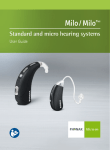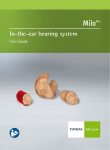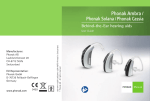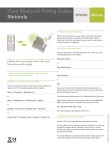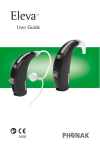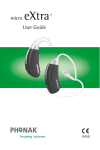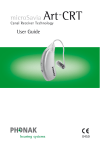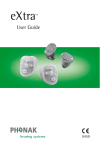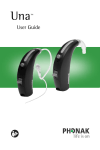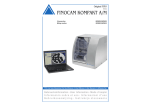Download User Manual OK OK Plus BTE
Transcript
Standard hearing systems User Guide Contents 1. Welcome 4 2. Important information: Please read before operating your hearing system for the first time 6 Hazard warnings 6 Information on product safety 8 3. Hearing system description 10 4. Step-by-step instructions for using the hearing system 13 2 Step 1. Getting to know your hearing system 13 Step 2. Battery preparation 15 Step 3. Inserting the battery 15 Step 4. Turning on the hearing system 16 Step 5. Inserting the hearing system 17 Step 6. Adjusting the volume control behind the ear 23 Step 7. Selecting the hearing program behind the ear 24 Step 8. Removing the hearing system 25 Step 9. Turning off the hearing system 27 Step 10. Changing the battery 28 Step 11. Changing the battery in hearing systems with a tamper proof battery compartment 28 5. Care and maintenance 30 6. Troubleshooting 32 7. Telecoil 33 8. FM systems 34 9. Service and warranty 35 10. Information and explanation of symbols 36 3 1. Welcome Your new hearing system is a premium Swiss quality product. It was developed by Phonak, one of the world‘s leading companies in hearing technology. Your hearing system offers the most modern digital hearing technology currently available on the market. Phonak has implemented this hearing technology into hearing systems that are simple and easy to use. Many automatic functions offer maximum sound quality, the highest speech clarity, and optimal hearing comfort in almost all hearing situations. We are convinced that the outstanding performance of your hearing system will provide valuable benefits to your daily life. Please read these user instructions thoroughly in order to benefit from all the possibilities your new hearing system has to offer. With proper use and care, you will be able to enjoy your hearing system for many years to come. 4 If you have any questions, please consult your hearing care professional. Phonak - life is on www.phonak.com 0459 5 2.Important information Please read the information on the following pages before using your hearing system. 2.1Hazard warnings Use only hearing systems that have been specially programmed for you by your hearing care professional. Other systems may be ineffective and may, in certain cases, damage your hearing. Changes or modifications to the hearing system that were not explicitly approved by Phonak are not permitted. Such changes may damage your ear or the hearing system. Hearing system batteries are toxic if they are swallowed! Keep out of reach of children and pets. If batteries are swallowed, consult your physician immediately! 6 In very rare cases, the dome can remain in your ear canal when removing the hearing tube from the ear. In the unlikely case that the dome does get stuck in your ear canal, it is strongly recommended to see a physician for safe removal. The hearing system contains small parts which can be swallowed by children. External devices may only be connected if they have been tested in accordance with corresponding IECXXXXX standards. Only use accessories approved by Phonak AG. 7 2. Important information 2.2 Information on product safety Never immerse your hearing system in water! Protect it from excessive moisture. Always remove your hearing system before showering, bathing, or swimming. Protect your hearing system from heat (never leave it near a window or in the car). Never use a microwave or other heating devices to dry your hearing system. Ask your hearing care professional about suitable drying methods. 8 When you are not using your hearing system, leave the battery compartment open so that any moisture can evaporate. Make sure that you always completely dry your hearing system after use. Store the hearing system in a safe, dry and clean place. Do not drop your hearing system! Dropping onto a hard surface can damage your hearing system. Always use new batteries for your hearing system. You can return used batteries to your hearing care professional. Remove the battery if you are not using your hearing system for a long period of time. X-ray radiation (e. g. CT scans, MRI scans) may adversely affect the correct functioning of your hearing systems. We recommend that you remove them before undergoing X-ray procedures and keep them outside the room. Do not use your hearing system in areas where electronic equipment is prohibited. 9 3. Hearing system description The following user instructions describe: the standard hearing system. The standard hearing system can be adapted with a variety of earmolds. On the following pages use the labeled drawings to identify the hearing system and the earmold that you use. Your hearing care professional will tell you what size of battery you need for your hearing system. 10 Standard model Option A: with classic earmold e f g d h c b a a b c d e f g h Right or left indicator (right=red, left=blue) Battery compartment with ON/OFF switch Volume control Program switch (only for OK! Plus) Microphone input Hook/sound output Hearing tube Classic earmold 11 3. Hearing system description Standard model Option B: with dome f e d g c h b a a b c d e f g h 12 Right or left indicator (right=red, left=blue) Battery compartment with ON/OFF switch Volume control Program switch (only for OK! Plus) Microphone input Hook/sound output Hearing tube Earmold: adapter with dome (EasyFit) 4. Step-by-step instructions for using the hearing system The following chapter provides step-by-step instructions on how to use your hearing system. Please follow these steps carefully. In the drawings, the parts that are particularly important for each step are shown in green. Step 1. Getting to know your hearing system Take the hearing instrument in your hand and try out the hearing system controls. This will make it easier for you to feel and operate the controls later on when wearing the hearing system. 13 4. Using the hearing system To increase the volume, press the volume control upwards. To decrease the volume, press the volume control downwards (Fig. 1a). Increase volume Decrease volume Fig. 1a In order to change a hearing program, press the program switch displayed (Fig. 1b) (only for OK! Plus). Fig. 1b 14 Step 2. Battery preparation Remove the protective foil from the new battery (Fig. 2). Wait for two minutes before inserting to activate the battery. Fig. 2 Step 3. Inserting the battery Take the hearing system in your hand (Fig. 3a) and open the battery door. Insert the battery so that you see the + symbol on the battery (Fig. 3b). Fig. 3a Fig. 3b 15 4. Using the hearing system Step 4. Turning on the hearing system Switch on the hearing system by closing the battery compartment (Fig. 4). Fig. 4 Open and close the battery compartment gently and carefully. Check if you feel resistance when closing the battery compartment. Check to make sure the battery is correctly inserted and in the correct direction. If the battery is inserted the wrong way, the hearing system will not work and the battery compartment can be damaged. 16 The hearing system is now switched on. It can take up to 15 seconds before it starts. (When you wear the hearing system, you will hear an acoustic signal). Step 5. Inserting the hearing systems This step shows you how to correctly insert the hearing system. The type of earmold determines how the hearing system is inserted. Each hearing system is individually programmed for your right or left ear. For the first step identify right and left so you will be able to insert your hearing system in the correct ear. 17 4. Using the hearing system Step 5.1 Identifying the hearing systems for the right and left ear Color indicator: right = red left = blue Fig. 5a: Standard hearing system 18 Step 5.2 Inserting a hearing system with classic earmold With your right hand, take your earmold for the right ear (red mark on the hearing system, see step 5.1) between your thumb and forefinger (Fig. 5b). Take the earmold up to your ear (Fig. 5b). Place the ear canal part of the earmold into your ear canal (see the part circled in green, Fig. 5b). Next place the hearing system behind your ear (Fig. 5c). Then insert the upper part of the earmold into the upper part of the bowl of your ear (Fig. 5d). Fig. 5b Fig. 5c Fig. 5d 19 4. Using the hearing system If you have problems inserting the hearing system, use your other hand to gently pull your earlobe downwards. This opens the ear canal a little more and you can rotate the earmold until it fits correctly. Check the fit by running your finger over the bowl of the ear. You know it fits correctly if, when doing so, you feel the contour of the bowl of the ear and not the hearing system (Fig. 5e). In the beginning, please use a mirror to check. Fig. 5e You have now successfully inserted the right hearing system. Now insert your left hearing system in the same way (marked in blue, see step 5.1). 20 Step 5.3 Inserting the hearing system with a dome With your right hand, place the right hearing system (red mark on the hearing system, see step 5.1) behind your right ear (Fig. 5f). Place the hearing tube between your thumb and forefinger. Insert the dome deep enough into the ear canal so that the hearing tube lies flat on your ear (Fig. 5f/5g). Fig. 5f Fig. 5g 21 4. Using the hearing system If you have problems inserting the hearing system, use your other hand to gently pull your earlobe downwards. This opens the ear canal a little more and you can rotate the dome until it fits correctly. You have now successfully inserted the right hearing system. Now insert your left hearing system in the same way (marked in blue, see step 5.1). 22 Step 6. Adjusting the volume control behind the ear To increase the volume, press the volume control upwards. To decrease it, press the volume control downwards using your forefinger. Use your thumb to lightly support the hearing system (Fig. 6). Increase volume Decrease volume Fig. 6 Your volume adjustment will be saved. After turning the hearing instrument OFF and ON the last volume setting will start up. 23 4. Using the hearing system Step 7. Selecting the hearing program behind the ear (only for OK! Plus) In order to select or change a hearing program with the standard hearing system, press the program switch displayed in (Fig. 7). Fig. 7: Standard model If you press it again, you change to the next program. A signal indicates the change. A signal tone can only be easily heard if you have turned on the hearing system and you are wearing it correctly behind the ear. 24 Step 8. Removing the hearing system Step 8.1 Removing the hearing system with classic earmold Take the hearing system behind your ear (do not touch the tube!) and lift it above the upper part of your ear and then gently let go (Fig. 8a). Fig. 8a Use your thumb and forefinger to grasp the earmold in your ear (not the tube!) and gently remove it from your ear (Fig. 8b). Fig. 8b 25 4. Using the hearing system Step 8.2 Removing the hearing system with a dome Grasp the hearing system by the hearing tube and carefully remove it from your ear (Fig. 8c/8d). Fig. 8c Fig. 8d In very rare cases, the dome can remain in your ear canal when removing the hearing tube from the ear. In the unlikely case that the dome does get stuck in your ear canal, it is strongly recommended to see a physician for safe removal. 26 Step 9. Turning off the hearing system You can turn off your hearing system by opening the battery compartment (Fig. 9a). Fig. 9a: Standard model 27 4. Using the hearing system Step 10. Changing the battery Before the battery is completely empty, your hearing system will indicate to you that the battery soon needs to be changed with an acoustic signal. Once this happens, you have about 30 minutes (in some cases longer) to change the battery. The battery warning signal is repeated every half hour. We recommend that you always keep a spare battery on hand. Step 11. Changing the battery in hearing systems with a secured battery compartment The standard model has the option to be fitted with a tamper proof battery compartment if needed for safety reasons. The following example shows how the battery is changed. 28 Standard hearing system After you have opened the battery compartment, pull the plastic tab on top of the battery back until you feel it engage (Fig. 11a). Afterwards, press the tab up (Fig. 11b). “click” Fig. 11a Fig. 11b The old battery can now be replaced and a new one inserted (Fig. 11c). Place the plastic tab back over the battery and secure it before closing the battery compartment (Fig. 11d–11e). “click” Fig. 11c Fig. 11d Fig. 11e 29 5. Care and maintenance Diligent and routine care of your hearing system contributes to outstanding performance and a long service life. Please use the following specifications as a guideline: General information Before using hair spray or applying cosmetics, you should remove your hearing system from your ear, because these products may damage it. Never wash or clean the microphone protector. Doing so could cause it to lose its special acoustic features. Try to avoid touching this protection, e. g. when inserting or operating the hearing system. If you feel pain in or behind your ear, or if it is inflamed, please check with your hearing care professional or physician. 30 Daily Inspect the earmold and tube for earwax and moisture deposits. Clean the surfaces with a lint-free cloth. Never use cleaning agents such as household detergents, soap, etc. for cleaning your hearing system. If you need to clean your hearing system intensively, ask your hearing care professional for advice and information on filters or drying capsules. Weekly Clean the earmold with a soft, damp cloth or with a special cleaning cloth for hearing systems. For more in depth maintenance instructions or for more than basic cleaning, please see your hearing care professional. Monthly Inspect your hearing tube for color changes, hardening, or cracks. In the case of such changes, the hearing tube has to be replaced. Please see your hearing care professional. 31 6. Troubleshooting Hearing systems sound softer than usual / no sound First check whether you can adjust and make the sound louder with the volume control. Then check the hearing tube and earmold for earwax residue and clean if necessary. Check whether the battery is correctly inserted and properly fitted, adjust the fit if necessary. If there is no improvement, change the battery. If the problem persists, contact your hearing care professional. Battery discharges too quickly Insert a new battery and make note of exactly how long it lasts. Contact your hearing care professional with this information, they will be able to help and advise you. Crackling or buzzing noises Check the hearing tube and earmold for earwax residue. Check the hearing tube for damage (color changes, hardening, or cracks) and contact your hearing care professional if necessary for replacement. 32 Whistling Check whether the earmold is correctly and firmly fitted. If this is the case, but the problem persists, please consult with your hearing care professional. Pain or inflammation in your ear Remove the hearing system and consult with your hearing care professional. If the problem is serious, please contact your physician. 7. Telecoil (only for OK! Plus) OK! Plus offers a Telecoil (T-coil). The program with T-coil is used to listen to telephones that are compatible with hearing systems or via inductive loop systems (present in some school settings, theaters, churches etc.). 33 8. FM systems (only for OK! Plus) FM Systems are wireless communication systems consisting of a radio transmitter and a radio receiver. The transmitter is placed close to the sound source (e. g. TV/Radio/lectern). The sound is transmitted clearly and directly to the hearing system in the form of radio signals – without disruptive background noises or echoes. Phonak is a leader in FM communication. In order to take advantage of the benefits of these high-tech radio systems, consult with your hearing care professional. If you already have an FM system and need additional information on using this system, please consult the relevant user instructions on the FM transmitter or the FM receiver. For more information, please visit www.phonak.com, or ask your hearing care professional. 34 9. Service and warranty Phonak offers you a comprehensive, worldwide warranty, valid starting from the date of purchase. Please ask your hearing care professional about the term of the warranty valid in the country of purchase. The warranty covers repairs in case of processing and material errors. No warranty claims will be considered if the hearing system shows normal wear and tear, improper handling or care, exposure to chemicals, immersion in water or undue stress. In case of damage caused by third parties or non-authorized service, the Phonak warranty is null and void. This warranty does not cover services performed by a hearing care professional at his or her workplace. Serial number of the left hearing system Serial number of the right hearing system Purchase date: 35 10. Information and description of symbols XXXX With the CE symbol, Phonak AG confirms that this Phonak product – including accessories – meets the requirements of the Medical Devices Directive 93/42/EEC as well as the R&TTE Directive 199/5/EC on radio and telecommunications transmitters. The numbers after the CE symbol correspond to the code of certified institutions that were consulted under the above-mentioned directives. This symbol indicates that the products described in these user instructions adhere to the requirements for an application part of Type BF of EN 60601-1. The surface of the hearing system is specified as application part of Type BF. 36 This symbol indicates that it is important for the user to read and take into account the relevant information in these user guides. This symbol indicates that it is important for the user to pay attention to the relevant warning notices in these user guides. Important information for handling and product safety. Operating conditions The product is designed such that it functions without problems or restrictions if used as intended, unless otherwise noted in these user guides. 37 10. Information and description of symbols Transport and storage conditions During transport or storage, the temperature should not exceed the limit values of –20°/60° Celsius and relative humidity of 65% for a long period of time. The air pressure range between 500 and 1100 hPa is appropriate. The symbol with the crossed-out garbage bin is to make you aware that this hearing system may not be thrown away as normal household waste. Please dispose of old or unused hearing systems, at waste disposal sites intended for electronic waste, or give your hearing system to your hearing care professional for disposal. Proper disposal protects the environment and health. 38 www.phonak.com 0459 029-0351-02/V1.00/2009-09/A+W Printed in Switzerland © Phonak AG All rights reserved Manufacturer: Phonak AG Laubisrütistrasse 28 CH-8712 Stäfa Switzerland








































